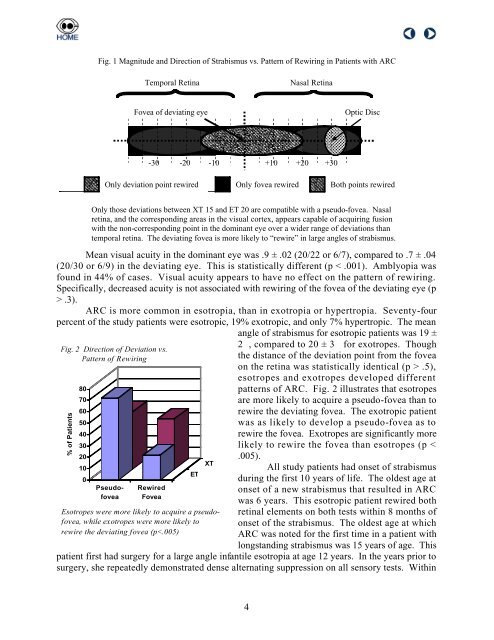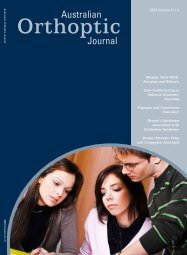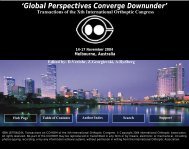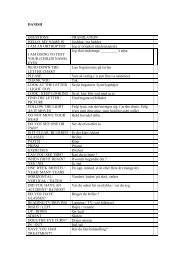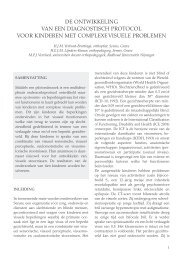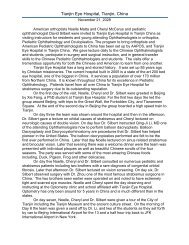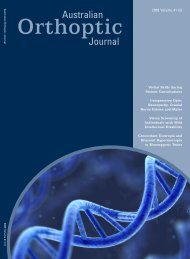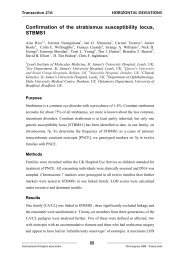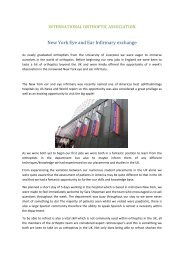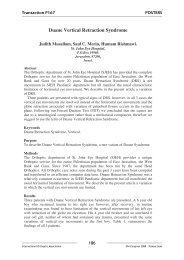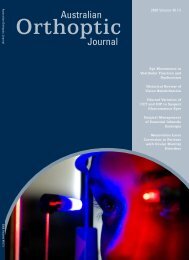Transactions from the Xth International Orthoptics Congress 2004
Transactions from the Xth International Orthoptics Congress 2004
Transactions from the Xth International Orthoptics Congress 2004
Create successful ePaper yourself
Turn your PDF publications into a flip-book with our unique Google optimized e-Paper software.
Fig. 1 Magnitude and Direction of Strabismus vs. Pattern of Rewiring in Patients with ARC<br />
Temporal Retina<br />
Nasal Retina<br />
Fovea of deviating eye<br />
Optic Disc<br />
-30 -20 -10<br />
+10 +20 +30<br />
Only deviation point rewired<br />
Only fovea rewired<br />
Both points rewired<br />
Only those deviations between XT 15 and ET 20 are compatible with a pseudo-fovea. Nasal<br />
retina, and <strong>the</strong> corresponding areas in <strong>the</strong> visual cortex, appears capable of acquiring fusion<br />
with <strong>the</strong> non-corresponding point in <strong>the</strong> dominant eye over a wider range of deviations than<br />
temporal retina. The deviating fovea is more likely to “rewire” in large angles of strabismus.<br />
Mean visual acuity in <strong>the</strong> dominant eye was .9 ± .02 (20/22 or 6/7), compared to .7 ± .04<br />
(20/30 or 6/9) in <strong>the</strong> deviating eye. This is statistically different (p < .001). Amblyopia was<br />
found in 44% of cases. Visual acuity appears to have no effect on <strong>the</strong> pattern of rewiring.<br />
Specifically, decreased acuity is not associated with rewiring of <strong>the</strong> fovea of <strong>the</strong> deviating eye (p<br />
> .3).<br />
ARC is more common in esotropia, than in exotropia or hypertropia. Seventy-four<br />
percent of <strong>the</strong> study patients were esotropic, 19% exotropic, and only 7% hypertropic. The mean<br />
angle of strabismus for esotropic patients was 19 ±<br />
Fig. 2 Direction of Deviation vs.<br />
Pattern of Rewiring<br />
% of Patients<br />
80<br />
70<br />
60<br />
50<br />
40<br />
30<br />
20<br />
10<br />
0<br />
Pseudofovea<br />
Rewired<br />
Fovea<br />
ET<br />
XT<br />
Esotropes were more likely to acquire a pseudofovea,<br />
while exotropes were more likely to<br />
rewire <strong>the</strong> deviating fovea (p .5),<br />
esotropes and exotropes developed different<br />
patterns of ARC. Fig. 2 illustrates that esotropes<br />
are more likely to acquire a pseudo-fovea than to<br />
rewire <strong>the</strong> deviating fovea. The exotropic patient<br />
was as likely to develop a pseudo-fovea as to<br />
rewire <strong>the</strong> fovea. Exotropes are significantly more<br />
likely to rewire <strong>the</strong> fovea than esotropes (p <<br />
.005).<br />
All study patients had onset of strabismus<br />
during <strong>the</strong> first 10 years of life. The oldest age at<br />
onset of a new strabismus that resulted in ARC<br />
was 6 years. This esotropic patient rewired both<br />
retinal elements on both tests within 8 months of<br />
onset of <strong>the</strong> strabismus. The oldest age at which<br />
ARC was noted for <strong>the</strong> first time in a patient with<br />
longstanding strabismus was 15 years of age. This<br />
patient first had surgery for a large angle infantile esotropia at age 12 years. In <strong>the</strong> years prior to<br />
surgery, she repeatedly demonstrated dense alternating suppression on all sensory tests. Within<br />
4


